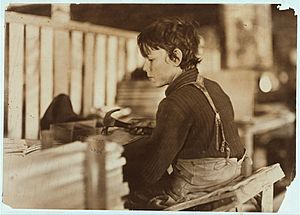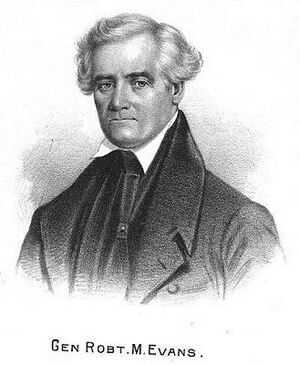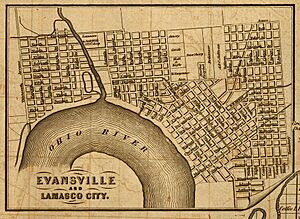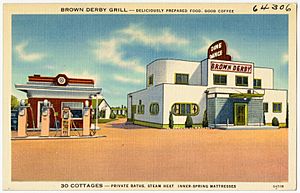History of Evansville, Indiana facts for kids
The history of Evansville, Indiana, goes back hundreds of years, with people living in the area for thousands of years. Its location on a bend in the Ohio River made it a popular place. The city was started in 1812 by Hugh McGary, who named it after Col. Robert M. Evans. Because of its river location and natural resources, Evansville grew into a major center for business, industry, and money in the tri-state area.
Contents
Ancient History of Evansville
People have lived in the Evansville area since at least 8,000 BCE. Scientists who study old civilizations have found several ancient sites nearby. The most important sites were at Angel Mounds from about 900 A.D. to 1600 A.D., just before Europeans arrived. These Native Americans were called "Mound Builders" and were part of the Mississippian culture. They were skilled hunters and gatherers who built their villages on high ground near rivers.
No one knows exactly why the Angel Mounds civilization ended. Experts think a long drought or too much hunting might have played a part. Many of the Angel people may have moved downriver by 1450. Later, groups like the Shawnee and Miami tribes moved into the area around 1650 AD. When European settlers arrived, a group of Shawnee still lived by Pigeon Creek, where it met the Ohio River in what is now Evansville.
How Evansville Began
French hunters and traders were some of the first Europeans here. One trader, Pierre Brouillette, lived in Vincennes and traded with the Shawnee until about 1804.
In 1803, Hugh McGary Sr. and his family moved near Princeton. They often visited the Evansville area. On March 27, 1812, Hugh McGary Jr. bought almost 441 acres of land. McGary's land was on a high bluff by a horseshoe bend in the Ohio River. He thought it was safe from floods, but he was wrong. The city flooded many times, especially in the great flood of 1937.
To attract more people, McGary renamed his village "Evansville." He honored Col. Robert M. Evans, a local lawmaker and war hero. Evans served under General William Henry Harrison in the War of 1812. McGary also tried to get more people to buy land by making Evansville the "permanent" county seat. A new county, Warrick, was created in 1813 and included Evansville. But then Posey County was created, and Evansville became too far west for Warrick's county seat.
Robert Evans and James W. Jones bought a share of Evansville. A new map was made for about 200 acres, with streets running along the river. Evansville became a town in 1817 and a county seat on January 7, 1818. The county was named Vanderburgh, after a judge.
New churches also started in Evansville. The first Methodist church service was in 1819. The First Presbyterian Church began in 1821, and the General Baptist Church started in 1823. The first Roman Catholic church was built in 1836.
Evansville's economy grew in the 1830s when Indiana planned to build the Wabash and Erie Canal. This was meant to be the longest canal in the world, connecting the Great Lakes to the Ohio River. Evansville seemed set to become "The Crossroads of America."
However, the canal project cost the state a lot of money and didn't work well. By the time the Wabash and Erie Canal was finished in 1853, Evansville's first railroad had already opened. Railroads made canals old-fashioned. Only two boats ever traveled the whole canal. The canal area in downtown Evansville later became the site of a new courthouse in 1891.
West Side Community
For many years, the west side of Evansville was separated from the main city. Pigeon Creek and many factories made it hard to cross. When many German immigrants arrived in the late 1800s, the west side became even more separate. It developed its own unique culture and strong community spirit.
The area that became Lamasco was planned in 1837. In 1839, it became a town called Lamasco. This name came from parts of the last names of its founders: John and William Law, James B. MacCall, and Lucius H. Scott.
Lamasco and Evansville were separate towns for twenty years, but they acted like one community. In 1857, the part of Lamasco east of Pigeon Creek joined Evansville. The part west of the creek stayed independent and was called "Independence."
After the 1848 Revolution in Europe and the American Civil War, many Germans moved to the area. This increased the population, and Evansville decided to add Independence to the city in 1870. Some people wanted to create their own town called "Madduxport." But by early summer, Independence became part of Evansville. The name "Independence" was used for a while, but eventually, people just called it the "West Side."
Unlike downtown Evansville, Lamasco's streets were laid out perfectly north-south and east-west. This means that when you go between downtown and the west side, the streets make a confusing turn.
Growth in the Late 1800s
Economic Boom
The first newspaper, The Evansville Courier, started in 1845. But Evansville grew the most after the American Civil War. Evansville was a key stop for steamboats on the Ohio River. Many companies used the river for trade. Three famous buildings from this time are the Old Post Office (1870s), Willard Library (1880s), and the Old Courthouse (1890s).
Evansville's location and natural resources helped its economy grow. Coal mines started near Evansville in the 1850s. By 1900, there were 10 mines in or near the city. These mines provided fuel for many businesses and factories.
Lots of hardwood lumber from the region helped a growing lumber and furniture industry. By 1900, Evansville was one of the biggest hardwood furniture centers in the world. There were 41 factories employing about 2,000 workers. Wealth from mining, factories, and trade led to beautiful Victorian homes in the Riverside Drive area. The grand home of lumber boss John A. Reitz and his son, Francis Joseph Reitz, is now a museum.
Evansville became less reliant on steamboats and more important for railroads. In 1887, the Louisville and Nashville Railroad built a bridge across the Ohio River. The railroad also built a large rail yard southwest of Evansville. A new town called Howell was created for railroad workers. In 1916, Evansville added Howell to the city.
People and Changes
During this time, Evansville's main groups of people were Germans escaping Europe, Protestant Scotch-Irish from the South, Catholic Irish working on canals or railroads, businessmen from New England, and newly freed slaves from Kentucky. By the 1890 U.S. census, Evansville was the 56th largest city in the United States.
Evansville also played a big role in state government. From 1861 to 1867, Conrad Baker was the Lieutenant Governor. From 1867 to 1873, he was the Governor of Indiana. Also, Evansville native John W. Foster served as the U.S. Secretary of State under President Benjamin Harrison from 1892 to 1893.
One famous resident was Albion Fellows Bacon (1865 – 1933). She was known as a "municipal housekeeper" during the Progressive Era. This term meant women who used their home-making skills to solve community problems.
Early 1900s in Evansville

As the new century began, homes continued to be built towards the east. New neighborhoods like Bayard Park Neighborhood, Washington Avenue, and Lincolnshire grew. Factories also boomed, especially in cars and refrigerators. Chrysler started making Plymouths on the city's north side. Companies like Seeger, Sunbeam, and Servel made iceboxes.
Around this time, a group called the Indiana Klan started in Evansville. In 1920, Joe Huffington was chosen to begin an official Indiana chapter of the Ku Klux Klan. He set up his first office in Evansville. There, Huffington met D.C. Stephenson, who became a leader in the group. The organization grew very powerful. However, scandals later damaged the group's reputation, and many members left.
Benjamin Bosse, Evansville's mayor from 1912 to 1922, had a motto: "When everybody boosts, everybody wins." This phrase described a time of great growth and wealth for the area. The city saw huge growth, especially in lumber and furniture making. By 1920, there were over two dozen furniture companies in Evansville.
In the 1920s and 1930s, city leaders worked to improve Evansville's transportation. Evansville successfully became part of the "Dixie Bee Highway" (U.S. Highway 41). A bridge was built across the Ohio River in 1932. In the same decade, plans for an airport began.
Like other places, the Great Depression of the 1930s brought high unemployment and business failures. In 1937, a huge flood covered 500 city blocks. After this, city and federal officials built levees for about fifty years. These walls and earthen mounds now hide the Ohio River behind them.
Just before World War II, oil was discovered nearby, bringing an economic boom. This also led to gambling places and a horse racetrack at Ellis Park.
Evansville in World War II
During World War II, Evansville became a major center for making things for the war. This helped end the last effects of the Great Depression. During the war, jobs jumped from 21,000 to 64,000 in just a few months. People from all over the tri-state area moved to the city for these new jobs.
A huge shipyard was built on the riverfront. It was 45 acres large and made oceangoing LSTs (Landing Ship-Tanks). The Evansville Shipyard was the nation's biggest inland maker of LSTs. The USS LST-325 is now in Evansville as a museum to remember these ships and the city's war effort.
The Plymouth car factory was changed into a plant that made "bullets by the billions." Many other companies also started making war materials. In 1942, the city got a factory near the airport to make P-47 Thunderbolt fighter planes. This factory later made Whirlpool appliances. Evansville produced 6,242 P-47s, which was almost half of all the P-47s made during the war.
After the War
After the war, the shipyard and aircraft plant closed. But jobs in the city still grew. Evansville's factories made cars, home appliances, and farm equipment. These products were in high demand after the war. More homes were needed, so building spread north across Pigeon Creek and east across Weinbach Avenue.
By the late 1950s, these new neighborhoods encouraged the growth of large shopping centers. North Park opened on First Avenue, Lawndale on Green River Road, and in 1963, Indiana's first covered mall, Washington Square. In the following years, Green River Road on the city's east side, including Eastland Mall, became the main shopping area.
To make downtown areas new again and bring businesses back, city leaders started tearing down older buildings. Some important landmarks were removed, like Assumption Cathedral and the old Central High School. From 1958 to 1963, almost $30 million was spent on urban renewal. Another $25 million was spent in 1968 on a Civic Center Complex.
After the Korean War, there was a recession that hit Evansville hard. This was because the city relied on industries connected to defense. Servel (which made refrigerators) closed, and Chrysler stopped its local operations. The economy was saved by 28 businesses that moved to the area between 1955 and 1963. These included Whirlpool, Alcoa, and General Electric.
In the last part of the 20th century, Evansville became a strong center for business, medicine, and services for the tri-state region. From 1981 to 1989, Evansville native Robert D. Orr served as the Governor of Indiana.
The 1990s saw an economic boost. The University of Southern Indiana grew to over 10,000 students. Big companies like Toyota and AK Steel opened plants. Also, Tropicana Evansville (Indiana's first gaming boat) arrived, creating more jobs and economic activity.
Evansville in the 2000s
As the twenty-first century began, Evansville continued to grow its economy and become more stable. In 2000, Vectren was formed by combining two utility companies. It stayed in downtown Evansville, keeping thousands of jobs in the area. Berry Plastics and Old National Bank also grew a lot. This growth led to big changes along Evansville's riverfront in just 15 years, with a new Tropicana casino and new main offices for Vectren and Old National Bank.
On November 6, 2005, an F3 tornado hit the Evansville area and killed 25 people. The tornado started in Kentucky and crossed the Ohio River. It hit Ellis Park Racecourse, a mobile home park, and then Newburgh. It left a path of damage for over 40 miles. Nearly $85 million in damage was done. After the tornado, a leader from the Federal Emergency Management Agency said, "I don't think I've ever seen a community of people come out so quickly to help each other."
Efforts to bring life back to downtown continued into the 2000s. Many new homes and apartments were built downtown. In 2011, a new indoor arena, the Ford Center, opened with seats for 11,000 people.
Evansville has also influenced culture. It is home to the annual West Side Nut Club Fall Festival. Kyle Starks, a famous comic-book writer and artist, is also from Evansville.






